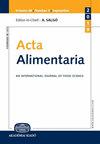Influence of the harvesting seasons on the polyphenol composition and antimicrobial activity of stinging nettle (Urtica dioica L.) extracts
IF 1
4区 农林科学
Q4 FOOD SCIENCE & TECHNOLOGY
引用次数: 0
Abstract
Abstract The aim of our research was to study the water and ethanol extractable polyphenols of stinging nettle ( Urtica dioica L.) harvested in different seasons and to determine their antimicrobial activity against certain human pathogenic and food spoiling bacteria and yeasts. Our results indicate that the spring leaf extracts had higher polyphenol contents than the root one; however, close to the end of the vegetation period these values decreased considerably in both leaves and roots. Detection and quantification of the most abundant phenolic compounds in the spring extracts by HPLC revealed the occurrence of 12 different phenol carboxylic acids and flavonoids. Flavonoid compounds were more abundant than phenol carboxylic acids in the leaves; however, their proportion was equal in the case of the roots. Nettle leaf extracts had remarkable antimicrobial activity, the spring extracts were more efficient than the autumn ones. Escherichia coli and Staphylococcus aureus were sensitive to every leaf extract, while Listeria monocytogenes and Pseudomonas aeruginosa had reduced but remarkable sensitivity patterns. Among the yeasts, Candida glabrata was strongly inhibited by the aqueous leaf extracts. Most of the strains were insensitive to the root extracts, although Enterococcus faecalis was inhibited by the root and not the leaf extracts.采收季节对刺荨麻提取物多酚成分及抑菌活性的影响
摘要本研究旨在研究不同季节采收的刺荨麻(Urtica dioica L.)水提物和乙醇提取物中的多酚类物质,并测定其对某些人类致病菌和食品腐败菌及酵母的抑菌活性。结果表明,春叶提取物的多酚含量高于根提取物;然而,在接近植被期结束时,这些值在叶和根中都显著下降。利用高效液相色谱法对春提取物中最丰富的酚类化合物进行检测和定量,发现存在12种不同的酚羧酸和黄酮类化合物。黄酮类化合物含量高于酚类羧酸;然而,在根的情况下,它们的比例是相等的。荨麻叶提取物具有显著的抑菌活性,春季提取物的抑菌活性高于秋季提取物。大肠杆菌和金黄色葡萄球菌对各叶提取物均有敏感性,单核增生李斯特菌和铜绿假单胞菌对各叶提取物的敏感性降低但显著。其中,叶片水提物对光念珠菌有较强的抑制作用。大多数菌株对根提取物不敏感,但粪肠球菌受到根而不是叶提取物的抑制。
本文章由计算机程序翻译,如有差异,请以英文原文为准。
求助全文
约1分钟内获得全文
求助全文
来源期刊

Acta Alimentaria
农林科学-食品科技
CiteScore
1.80
自引率
0.00%
发文量
47
审稿时长
18-36 weeks
期刊介绍:
Acta Alimentaria publishes original papers and reviews on food science (physics, physical chemistry, chemistry, analysis, biology, microbiology, enzymology, engineering, instrumentation, automation and economics of foods, food production and food technology, food quality, post-harvest treatments, food safety and nutrition).
 求助内容:
求助内容: 应助结果提醒方式:
应助结果提醒方式:


